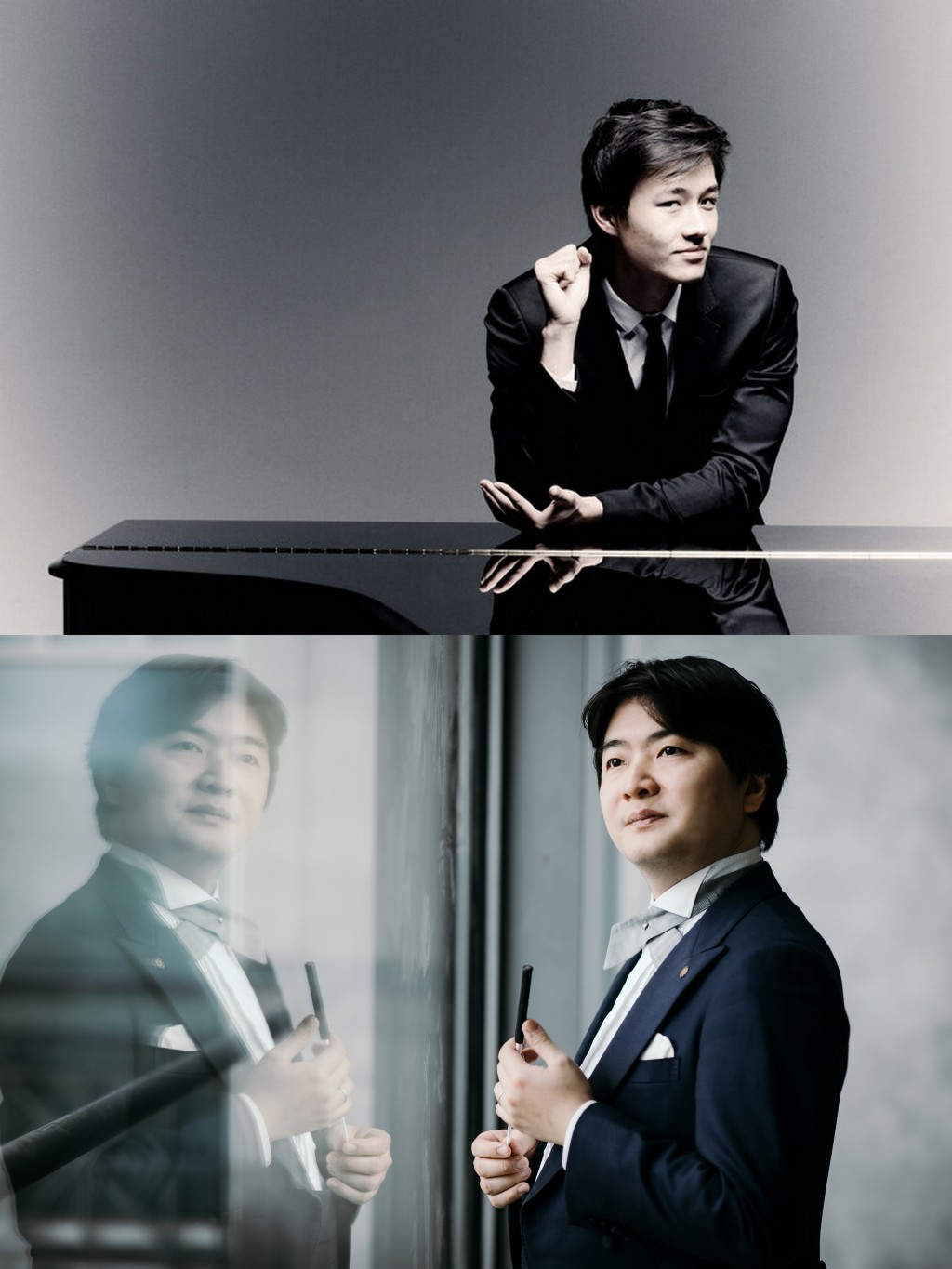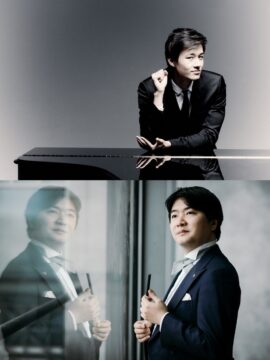The Victoria Hall in Geneva can proudly claim to have hosted orchestras and conductors of international repute. We still have in our ears and hearts the memorable evenings illuminated by the Vienna Philharmonic, with Riccardo Chailly, and the Royal Concertgebouw Orchestra conducted by Myung-Whun Chung. Tonight, it's the turn of the City of Birmingham Orchestra1. The CBSO's rise to world-renowned orchestra status can be largely attributed to its iconic conductors. Sir Simon Rattle, who took over the orchestra in 1980, was one of the most influential figures in its history. Under his baton, the CBSO became a major player on the international music scene. Rattle's commitment to musical excellence and his ability to interpret both classics and contemporary pieces helped shape the orchestra's identity. After Rattle, Andris Nelsons continued this tradition of excellence, bringing his energy and passion. More recently, Mirga Gražinyte-Tyla became the first woman to lead the orchestra, providing a fresh direction and perspective while respecting the traditions established by her predecessors. These conductors, with their unique approaches and individual talents, played a crucial role in shaping the CBSO's trajectory, making it the prestigious ensemble it is today. At the helm tonight, Kazuki Yamada, conductor of the Monte-Carlo Philharmonic but very close to the CBSO, offers an eclectic program, with a strong focus on two Russian works marked by their sense of pastiche, mixing, and self-quotation, and a piano concerto by Saint-Saëns between classicism and romanticism.
A serene Symphony No.1
In his journal, Prokofiev, just before the creation of his Symphony No.1 in D major op. 25 "Classical", wrote: "my true friends will see that the style of my symphony is precisely of a Mozartian classicism and they will give it its true value, while the audience will just be happy to hear a cheerful and uncomplicated music, which of course, they will applaud!" It is in this spirit of clarity and simplicity that the conductor conceived his interpretation, but with sometimes puzzling choices, especially regarding tempo, surprisingly measured. Yamada offers a comfortable, very airy, playful vision, with a beautiful and amiable rhythmic regularity. His conducting style, an improbable hybrid of Bernstein and Ozawa, captures attention, creating a clear rapport with the orchestra. In the second movement, Yamada evokes a series of musical pastiches, Mozart, of course, but also echoes of Ponchielli's "Dance of the Hours" as the whole sounds like a delicate clock ticking away. There was a particular grace in this interpretation, a distinct British charm that brings a smile. In the third, very bouncy movement, the conductor remains faithful to a still contained tempo, exploring the pastiches and mixes of this sunny and amusing work. More engaged, the final movement, a tribute to Beethoven, filled with bounding and comical energy, a celebration of joy, allows Yamada, conducting with palpable vigor, the opportunity to showcase all sections of the orchestra. However, despite this cheerful atmosphere, there's still a certain restraint, as if part of Prokofiev's original spirit had been muted.
Romantic renaissance, with Saint-Saëns' Piano Concerto No.2 by Louis Schwizgebel
First movement (Andante sostenuto): the opening of this movement captivates from the first moments, immersing us in an introspective universe rich in emotions. Despite being composed in haste, this concerto reveals a depth that showcases Saint-Saëns' mastery of composition. The solemn entrance, reminiscent of an organ improvisation, immediately establishes a collected and majestic atmosphere. It evokes great gothic cathedrals, where chords resonate between ancient arches. Louis Schwizgebel, with his impressive mastery, steps into this solemnity. Every chord he strikes seems weighed, measured, and delivered with an intensity that commands respect. His fingers glide across the keyboard with confidence betraying hours of relentless practice and an intimate understanding of the piece. Echoes of Bach that arise are a nod to the past, a wink to the masters who paved the way for compositions like this. But Schwizgebel doesn't stop there. Navigating through these nuances, he manages to infuse modernity, a freshness reminding us why this concerto remains so relevant today. When the orchestra emerges, it's with the gravity of the opening of Mozart's Don Giovanni. Schwizgebel then becomes not just a pianist but also a storyteller, telling a rich tale of contrasts, emotions, and twists. His ability to juggle between Beethoven-like passages and romantic tumults is impressive. There's a strength, a robustness in his play evoking great passions, but there's also a subtlety, a delicacy reminiscent of the tenderest moments of romanticism. This duality, this balance between power and gentleness, makes this first movement an unforgettable auditory experience, an invitation to get lost in Saint-Saëns' genius and Schwizgebel's immeasurable talent. His interpretation of the first movement is particularly noteworthy. Although he adopted a deliberate approach, different from pianists like Grosvenor or Hough, Schwizgebel incorporated dazzling personal touches. For instance, in the "languido" section of the cadenza, he gave a gradual dynamic to the octaved arpeggios, playing with incredible sensitivity.
Second movement (Allegro scherzando): this movement stands in stark contrast to the introspective solemnity of the first. As its name suggests, the scherzando character is light, teasing, almost mischievous. In this section, Saint-Saëns demonstrates his ability to create an entirely different atmosphere, infusing a refreshing liveliness that evokes images of a joyful dance in a candlelit salon. Approaching this movement, Louis Schwizgebel drastically changes his register. His technical prowess is tested as the notes soar swiftly, with each melodic phrase executed with surgical precision. His play here is sparkling, lively, and every note seems to dance under his fingers. The agility with which he navigates the keyboard is a sheer delight for both eyes and ears. Transitions between phrases flow smoothly, with each passage naturally leading to the next, creating a relentless musical current that sweeps the listener away. Schwizgebel's keystrokes resonate with airy lightness, and there's an almost playful quality to his interpretation of this movement. Where the first movement was a deep exploration of the human soul, the second celebrates the joy of life. Rhythmic themes, variations, and recurring motifs are approached with contagious energy, reminiscent of the carefree days of youth. However, while preserving this lightness, Schwizgebel doesn't forget to inject some gravity when the moment demands. Reflective moments are skillfully placed, offering the listener a welcome respite before diving back into the scherzando frenzy. This ability to balance moods, to juggle between lightness and seriousness, showcases an artistic maturity and a deep understanding of the piece. In Schwizgebel's hands, this movement becomes a true ode to musical joy.
Third movement (Presto): the third and final movement is an explosion of energy that ties together all the previously explored themes and emotions, an invitation to a whirlwind conclusion, a triumphant celebration of the composer and performer's mastery. From the very first measures, Schwizgebel's fervor is evident. His fingers, already agile and expressive in the previous movements, seem invigorated, moving with lightning speed and precision. Trills, executed brilliantly, resonate with crystalline clarity, while the demanding cadences are approached with unshakable confidence. It's fascinating to observe how Schwizgebel navigates this musical maze, with each note carefully articulated and every phrase played with fiery passion. There's a tangible intensity in his performance, a kind of captivating urgency. The dialogue between the piano and orchestra reaches its zenith here. Exchanges are lively, almost electric, with each instrument responding to the other in a delightful musical play. Saint-Saëns has woven a complex soundscape, where themes are reintroduced and revisited, but with renewed energy and perspective. His approach to the Presto is both bold and respectful, exploring the boundaries of expression while staying true to Saint-Saëns's spirit. Crescendos and diminuendos are interpreted with a sensitivity that testifies to his deep connection with the music. Can one perhaps regret the relative overshadowing of the conductor, or consider that Yamada did everything to facilitate things for Louis Schwizgebel, stepping in at the last minute for the highly anticipated Fazil Say?
As an encore, the Prelude in B minor BWV 855A by Bach, arranged by Alexander Ziloti, confirms the blend of technique and passion of Louis Schwizgebel.
Symphonic Dances slightly restrained
First movement: Non Allegro: the Symphonic Dances, imbued with a sense of urgency, a blend of rhythmic energy and deep melancholy, are typical of Rachmaninov's Russian imprint. It's important to note that Rachmaninov, while composing this work, was nearing the end of his life and was looking back, both to his native Russia and to his own personal history. Faced with this movement, Kazuki Yamada had a significant challenge ahead of him. This movement requires both technical precision and profound emotional sensitivity. Despite his efforts, his direction at times seemed a bit reserved, perhaps overly respectful of the score, to the detriment of the raw energy that this music demands. Where a conductor like Kondrashin was able to elicit fiery, almost Dantesque visions from this music, Yamada seems to dwell more on the details. This results in a clean, controlled interpretation, but lacking the ferocity and raw passion that others have managed to extract from this piece. Comparisons with other conductors further highlight the contrast. When considering the almost ethereal charm and subtle beauty of the Royal Concertgebouw Orchestra under Ashkenazy, or the heavy, typically Slavic melancholy that Jansons managed to extract while directing the St. Petersburg Orchestra, one might find Yamada's interpretation somewhat static.
Second movement: Andante con moto (Tempo di valse): the second movement of the Symphonic Dances immerses us in an almost spectral ambiance, filled with nostalgia. The waltz that characterizes it evokes a melancholic elegance, suggesting images of an old ball, perhaps an echo of Rachmaninoff's memories of his native Russia. Under Kazuki Yamada's direction, this movement proves to be an enigma. While certain passages, like the solo of the first violin, exude emotional tension, others seem misplaced. His decision to opt for a slower tempo transforms this waltz into an introspective dance. Though full of charm, it sometimes feels overly distant. We sense echoes of Shostakovich, but this stylistic choice, intriguing as it may be, seems to at times deconstruct the very essence of the piece. The orchestra, under Yamada's baton, plays with remarkable clarity. The texture is airy, luminous, but missing is the feeling of oppression, so characteristic of this movement. The English horn solo, with its enticing timbre, brings a certain lightness to the waltz, but even this softness feels ambiguous against the darker backdrop of the movement.
Third Movement: Lento assai – Allegro vivace: Rachmaninoff's musical universe is an epic in itself, a constant quest for emotions, intensities, and passions. Through his works, the Russian composer has always sought to immerse us in the depths of the human soul, revealing its deepest desires, darkest fears, and most ardent hopes. The third movement of the Symphonic Dances perfectly illustrates Rachmaninoff's innate talent for evocation. From the first measures of the Lento assai, we are invited to introspection, a journey into the intricacies of our consciousness. Each note, each melody is like a reflection of our own existence, a window into our dreams and regrets. But this is only a prelude, for with the Allegro vivace, Rachmaninoff thrusts us into a whirlwind of emotions. We should feel transported, caught up in a frenzied dance where each instrument of the orchestra carries us further, higher, towards a pinnacle of musical ecstasy. It is in this context that Kazuki Yamada's direction should be assessed. Alas, the promised journey seems incomplete. If Rachmaninoff is the tumultuous ocean described by Horowitz, Yamada's interpretation is a calm river. Certainly beautiful, certainly majestic, but lacking those unleashed waves, those passionate storms that are Rachmaninoff's signature. The echoes of Mussorgsky are there, bringing flashes of color, moments of light to this soundscape. But where is the fire, the urgency, the intensity? When the Dies Irae theme appears, there is a gravity, a solemnity. But even there, anticipation remains. We hope for a crescendo, an explosion, a climax. It's undeniable that the orchestra, under Yamada's direction, delivers a technically impeccable performance. Each note is played with precision, each melody rendered with clarity. But music, especially that of Rachmaninoff, is not just about technique. It's a matter of soul, heart, and passion.
The orchestral encore, "Lezginka", an excerpt from Khachaturian's ballet Gayaneh, might be the highlight of the evening with an uninhibited, whirlwind conductor, free, audacious, moving among the musicians, showcasing all that this piece owes to Borodin, in a committed interpretation adorned with a thousand colors, culminating in an apotheosis that concludes the evening.
Philippe Rosset
October 25, 2023.
In 1957, Gottlieb Duttweiler, the founder of Migros, incorporated the "Pour-cent culturel Migros" as an independent corporate objective in its bylaws. Since then, Migros has passionately and visionarily committed itself to enhancing sustainable quality of life and strengthening social cohesion, not only in its core business but also beyond. This unique commitment is reflected in the organization of symphonic music concerts and the support of the creation and promotion of shows and concerts in partnership with cultural institutions in the Geneva region. The goal is to foster a dynamic, rich, and diverse cultural life.
October 25, 2023.
1
This concert opens the season of the classics of the "Migros Cultural Percent":In 1957, Gottlieb Duttweiler, the founder of Migros, incorporated the "Pour-cent culturel Migros" as an independent corporate objective in its bylaws. Since then, Migros has passionately and visionarily committed itself to enhancing sustainable quality of life and strengthening social cohesion, not only in its core business but also beyond. This unique commitment is reflected in the organization of symphonic music concerts and the support of the creation and promotion of shows and concerts in partnership with cultural institutions in the Geneva region. The goal is to foster a dynamic, rich, and diverse cultural life.



